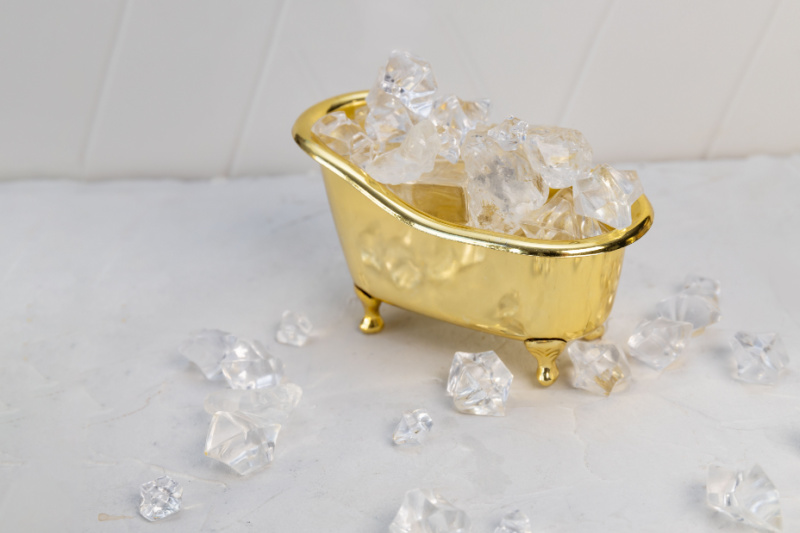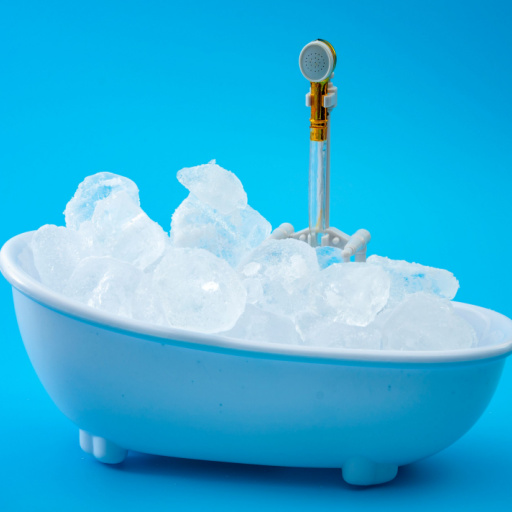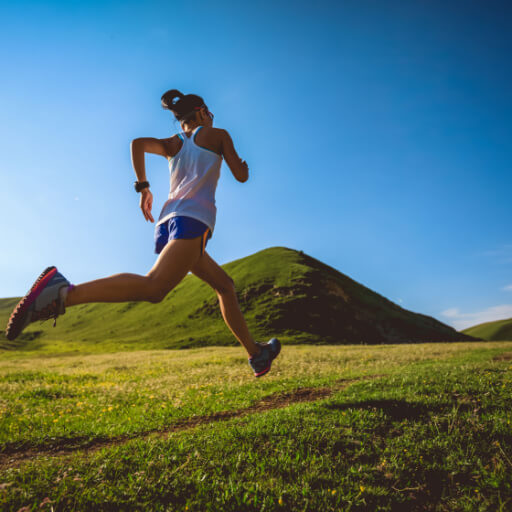Individuals often use many techniques to heal their bodies from fatigue and muscle pain endured during heavy training sessions. Ice bath therapy is making several heads turn for its healing effects these days. It has many benefits if your body can adapt well to it, so read on to know more.
इनके बारे में जानें:
- What research says about ice baths?
- How to make an ice bath?
- Potential benefits of ice baths
- Frequency for having ice baths
- Fact vs. Fiction: Debunking common myths about ice baths
- What are the risks involved with having ice baths?
- Cold showers vs. Ice baths: How do they compare?
What research says about ice baths?

Ice bath therapy may have become popular recently, but it is not a new practise. Many individuals and athletes have been using this method to heal muscle inflammation from the prolonged effects of training. While no definite research may back these claims, people have shown improvement after taking cold water baths for up to 10 minutes under supervision.
How to make an ice bath?
If you plan to reap the benefits of bathing in cold water or ice baths, you must first understand how to prepare one correctly.
- Timing and temperature control are critical. There are unique cold bathtubs that help regulate temperature so people don’t experience hypothermia.
- If this is your first time trying an ice bath, it is not advisable to go beyond 10-15 degrees Celsius. Time your bath to ensure it does not exceed 2-3 minutes.
- Try the water by dipping your feet first, so your body gets used to the temperature, before fully immersing yourself in it.
- Keep warm towels and blankets ready for when you exit the tub. Breathing evenly is essential; one shouldn’t panic while in a bath.
- If you are trying a DIY ice bath at home, fill it with cold water, add ice cubes, and stir them to distribute the temperature evenly. Insert a thermometer into the ice bath and ensure its tip is submerged in the water, not just touching the sides or bottom of the container. Wait for the thermometer to stabilize to get an accurate reading.
Potential benefits of ice baths
Ice baths are typically taken during warmer months. It is a boon for you, especially if you struggle with chronic muscle pains after exercise and workouts. They not only soothe muscle pain but quicken your recovery as well. Ice baths also support your immunity and reduce inflammation. In addition, cool water can calm your nervous system and help manage stress. Ice baths also increase your energy exponentially and help release dopamine and serotonin levels, which can improve your mood and sleep cycle.
Helps with sore muscles
Gymnasts, bodybuilders/trainers, and athletes suffer from sore muscles regularly. So, an ice bath here and there for 2-3 minutes will lull the pain drastically. Ice baths can relieve those who suffer from a chronic bone or muscle-related illness.
Supports immunity
Cold water can preserve cells from decaying, which is why ice baths are suitable for the immune system, too, as they help us fight illnesses and improve our nervous and lymphatic system functions.
Reduces inflammation
Increased body temperature and sweating may increase the chance of infections, inflammation, and soreness, but an icy cold bath does the opposite. It calms muscle spasms and the burning sensation. Cold water plunges are a form of cryotherapy wherein cold water or ice packs are used to treat swellings or similar issues. This is why people sometimes advise using a cold compress for swelling and inflammation caused by an injury.
Frequency for having ice baths
Even though cold baths have improved many people’s lives, one shouldn’t take more than two or three baths per week because going overboard with this practise involves some risks.
Fact vs. Fiction: Debunking common myths about ice baths
Here are some common myths around ice baths:
- Misconception 1: Ice baths are exclusively for professional athletes.
Reality: While it’s true that professional athletes often incorporate ice baths into their recovery routines, the advantages of ice baths are not limited to them. Ice baths are incredibly beneficial for anyone who wants to become healthier and fitter.
- Misconception 2: The experience of taking an ice bath is uncomfortable.
Reality: There’s no denying that the initial plunge into cold water can shock you. However, it’s important to note that the initial discomfort decreases as you become accustomed to the practise. The aforementioned refreshing benefits are often reported to far outweigh the initial pain.
- Misconception 3: The sole purpose of ice baths is muscle recovery.
Reality: While muscle recovery is a significant benefit of ice baths, it is essential to recognize its broader impact on overall well-being. Ice baths reduce inflammation, enhance circulation, alleviate stress, and refresh your mind, among other advantages.
What are the risks involved with having ice baths?
There are certain risks associated with ice baths.
- If you go overboard with the bath time, the risk of hypothermia is enormous. So, pay extra attention while you time your ice bath.
- ऐसे लोग जिन्हें type 1 and 2 diabetes and high blood pressure are at a higher risk of getting a heart attack or stroke if they spend a long time in an ice bath.
- The cold temperature of an ice bath can constrict the blood vessels, which decreases the movement of immune cells and slows down their ability to fight infections. Ice baths may not directly cause a cold but can temporarily weaken the immune system, making you susceptible to catching a cold. Individuals not used to the cold sensation may fall sick and are also vulnerable to frostbite.
- Ice baths are not suitable for children under the age of 12 as their bodies may not be able to tolerate the cold temperature as well as adults. They should only go for an ice bath if a professional has prescribed it.
In the case of hypothermia, follow these emergency procedures that may help reduce its severity.
- Remove the individual from the cold water immediately and layer them with warm blankets and a warm compress.
- Do not use hot water directly as that may damage the skin and cause the body temperature to not regulate correctly.
- Monitor their breathing and try to insulate their legs with the help of warm socks.
- Consuming hot or warm beverages helps regulate the body’s inner temperature and instantly relieves the pain.
Hot showers vs. Ice baths: How do they compare?
Here are 2 differences between hot showers and ice baths:
- Ice Baths are great for reducing muscle soreness and swelling and speeding up recovery after a challenging workout. This is because they compress blood vessels and slow metabolic activity. Warm Baths, on the other hand, help you relax and soothe those achy muscles by getting more blood flowing. They can also be a game-changer for your sleep quality by helping you unwind.
- Ice Baths also open up the blood vessels again to clear out metabolic waste, which triggers a soothing response that helps dial down stress. Warm baths are all about opening up those blood vessels, which improves circulation and oxygen flow and helps break down lactic acid in your muscles.
Although cold baths are therapeutic, exercise precaution while plunging into one and consult a specialist before opting for an icy cool bath.
Stay tuned to the Activ Living Community. Keep up to date with the latest health tips and trends through expert videos, podcasts, articles, and much more in पोषण, फिटनेस, सचेतन, और लाइफस्टाइल से जुड़ी बीमारियां like Asthma, Blood Pressure, Cholesterol, and Diabetes. Activ Living ke saath sahi sehat ki shuruaat ABHIkaro.
You may also be interested in the following blogs:
- Pedal Your Way To Better Health And Happiness With Cycling
- 10K Steps A Day Seems Difficult? Do It Like A Pro With These 3 Easy Ways
Popular Searches
How to lower blood pressure | Fruits good for liver | Unhealthy foods | रागी के लाभ | बेसल मेटाबोलिक रेट | हाई ब्लड प्रेशर के लिए एक्यूप्रेशर पॉइंट्स | Ayurvedic medicine for blood pressure | How to control cholesterol at home | Homeopathy for Asthma | Biological Age | Home remedies for TB | Natural beta blockers | Negative effects of internet | Types of walking | ब्लड प्रेशर कैलकुलेटर | ब्लड शुगर कैलकुलेटर | BMI कैलकुलेटर





 1800-270-7000
1800-270-7000








